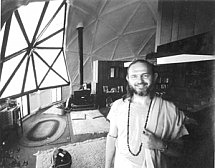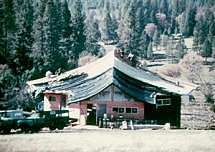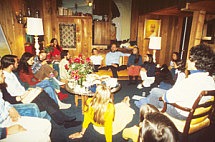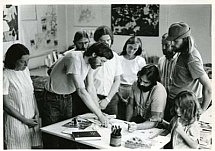Government
Although creativity was our foundation, one thing we learned in Ananda’s first summer was the need for some structure.
Our first attempts at organizing consisted of Town Council meetings, weekly or more often as needed. Everyone attended, and everything was discussed, from the mundane to the sublime, whether the question was how many times to ring the bell for lunch, or what pictures should be on the altar. Finding consensus was a long and arduous process. The dog issue, epitomized by a stray hound dog named Blue, really didn’t take months and months to resolve as sometimes is told in stories, but it certainly took many meetings. The larger issue was the presence of dogs in the community at all. Blue was a great example of why this question came up. At that time, there were also a few other dogs in the community. Some people were sentimentally attached to the idea of dogs, and others were highly opposed for all the obvious reasons. Blue was an OK dog in many ways, but he liked to bark and he especially liked to chase deer. No one seemed willing to take responsibility for Blue, so for many of us the argument was more than simply what to do about Blue. It was about arriving at and enforcing a policy of No Dogs which finally came to be part of our code: No Dogs, No Alcohol and No Drugs. This episode also illustrates the limitations of consensus decision-making and how a simple issue can polarize people.
People are More Important Than Things
Contributed by Devi Novak
Over the years of building Ananda Kriyananda has worn his innate air of authority and leadership lightly and naturally, never lording it over anyone. A few years ago he remarked to a few friends, “I recently received a letter from an Ananda member saying how much he admired my ability to accomplish things and to lead others. He needs to understand that I’m no different from anyone else. I’ve just been doing it a little longer.”

Swami kriyananda 70s at the Crystal Hermitage
Considerate and tactful, Swamiji tries to correct and guide others in their spiritual growth without hurting or discouraging them. Once, someone wrote a letter to my husband (Jyotish) and me criticizing our way of directing a certain aspect of Ananda. We were hurt by his words, which seemed to us unfair, but since we were about to attend a community Christmas celebration, we decided to say nothing about it to Swamiji until later.
As soon as he saw us at the gathering, however, he immediately asked, “What’s wrong?” After we’d explained about the letter, we asked him in humility, “Swamiji, we want to do the right thing. Please tell us, are the things he wrote about us true?”
After reflecting a moment he said, “You’re doing the best you can for who you are.” Trying to pin him down, I pressed further, “Well, was he wrong in writing the letter?” With wisdom inclusive of everybody’s reality, he answered, “He’s doing the best he can for who he is.” Then, with a twinkle of warmth and understanding in his eyes, he concluded, “And I’m doing the best I can for who I am.’
Decision Making
Kriyananda often left many important decisions, such as those regarding planning and land management, in the hands of other community members. However, when he felt strongly that principles were involved, he expected that his ideas at least be given serious consideration. In 1971, Kriyananda was offered a gift of $20,000 to have a new building constructed in which to house the Publications business. He had agreed to place the building on a site that had been chosen by others as a light industrial area, on a hill

Publications Building
above the Farm area. This caused a good deal of controversy, and in late summer 1971 he called a meeting to discuss this and other issues, particularly at the Farm. His idea of having a building that made an architectural and philosophical statement, placed where it could be easily seen, was challenged by a small group of people with inflexible opinions. The meeting quickly became acrimonious and the result was that about 50 people, many very peripheral to the community, decided to leave. It was a good lesson in the need for clear and effective leadership. It also pointed out the importance of looking at the big picture: setting aside ones likes and dislikes for a larger goal. And, it helped us define our direction of further growth.
This issue became symbolic for some people. How were these types of things to be decided? The problem with consensus is that very little can be done that is beyond the opinions and experiences of people. It is difficult in such a system to do anything bold.
Issues such as this one helped define Ananda and, as the community began to come into focus, those who felt uncomfortable with its emerging directions drifted away. This confrontation illustrated a conflict between an airy, but rather passive, idealism versus Kriyananda’s energetic visionary ideals. The first view embodies the psuedo-Native American view (with which many back-to-the-landers self identified), that the land is “sacred,” the second that land can be developed and used for positive human purposes.
With population growth came complexity. Visions about the nature of the community, its direction, growth, and financial decisions inevitably raised the question, “How do we decide this?” Would it be by consensus? That has proved very cumbersome. Appointed managers? Who appoints whom and why’some combination? Ananda evolved into a mixed system of appointed leaders who showed good community spirit, combined with a

Satsang at Swami’s home
tradition of allowing people who showed initiative, energy, and common sense to make decisions in their area of interest. Overlayed upon this was developed a way in which consensus could be workable: an elected Village Council which became the forum for community discussion where issues could be discussed and decisions arrived at, under the direction of appointed managers. Some people perceived this as undemocratic because Kriyananda held the ultimate moral authority to appoint community leaders, but most felt comfortable with this because of the additional fact of Ananda being an ashram, not simply a secular community. In such a model, authority is passed down through the spiritual leadership as it is in a monastery. Ultimately, Ananda has had a mixture of many forms and there has always been some ambiguity and flexibility. When people ask, “What is best for everyone?”, or “What does God want?”, rather than “What do I want?”, this kind of thinking leads very quickly to solutions.
Inner Testing
In 1973, while Swami Kriyananda was in India for an extended period, the community went through a time of inner testing after which several people left the community.
There was an attempt to write a charter for Ananda. This was done while Swamiji was in India. It was born out of frustration felt by a few of the residents that they didn’t have enough “clout” in making decisions.
Among other items in the charter was a limit on how long any person could serve as a leader and the limit they wanted to set would have meant that both Swamiji and Jyotish would have to step aside. When Swamiji got back from India, he met with the aforementioned people to say that he could not in good conscience go along with such an idea. This was, indeed, a line in the sand and a few of the families left soon after that.
In 1973, with Swami’s input, a corporation called Ananda Village, Inc. was set up to give legal structure to the community, and the name Ananda Farm was replaced by Ananda Village. As has already been mentioned, a Village Council was formed, the result of meetings that were held over the winter of 1972/73 to find a way to create a decision making body for day-to-day affairs of the community and as a forum for regular discussion of community issues such as roads, buildings, gardens, stray dogs, and community events. It served as a mechanism for imposing dues and fees upon members and a place to discuss membership.
Among the Village Council members at the first meeting on April 17, 1973 were Jyotish, Jaya, Seva and Devi. The original By Laws of Ananda Village provided for a Village Manager. As Jyotish had already been fulfilling that role, the corporate setup formalized this position.
Yoga Fellowship
At the same time that Ananda Village, Inc. was created, title to all the property was transferred from the names of individuals to that of the Yoga Fellowship. It was decided that membership in the Yoga Fellowship would be reserved for those who had been Ananda Village Members for at least five years. Swami was very concerned that the land be held by an entity that was more stable and dedicated to spiritual principles rather than by something like the Village corporation which allowed short time members to vote.
Master Plan
In 1974, we were offered the opportunity to purchase the 326 acres next to Ananda Village. We were able to raise funds for the purchase, and we made plans to move our retreat center, which became The Expanding Light, to this property. This brought our total acreage to 633, including the Meditation Retreats 72 acres. By this time, however, we had outgrown our original status as a church camp, and were required by the county government to provide a Master Plan before proceeding with any more construction. For us, this was quite challenging. We were outgrowing our facilities at a rapid pace, and few of us had even heard of a Master Plan.
The Master Plan Process
Contributed by Jaya Helin
The Master Plan process went from 1974 to 1978 when we received final permission to proceed. During that time, Sam Dardick, a neighbor and local planner, led the planning team, and one of the things we did with his direction was to conduct a series of neighborhood meetings on the Ridge to get information out to the public and receive input.
Sam, as an experienced planner, was very big on creating positive public relations. All along, as part of the creation of our Environmental Impact Report, we conducted engineering and other studies to address all the questions about how our development

Master Plan staff
would impact such things as water resources, wildlife, roads, school systems, etc. Because we worked on these for such a long time, and because the issues were before the public for all that time, when our proposal was first heard in an official capacity by the Nevada County Planning Commission, the questions were mostly of a technical nature as to filling in the blank spaces and details.
Although there was some questioning by the public about whether we had adequately addressed the issues, by the end most of the objective questions were answered. The Planning Commission gave us the OK and sent it to the Nevada County Board of Supervisors for approval.
It was here that a certain amount of subjective opposition arose, but it was not great. In fact, we had a number of people speak in our support. (Editor’s note: Real neighborhood opposition didn’t arise until later when we applied for incorporation in the early 1980s). However, the Planning Department staff members were not in favor of our proposal. Certainly they didn’t want to make it easy, or perhaps they were simply sticklers for the rules. We were breaking new planning ground in those days and were doing something with which planning departments were not familiar; in fact, Ananda may have been the first Planned Unit Development in Nevada County.
Certainly they had never encountered anything like us and didn’t know what to do, so they balked and played it safe. In retrospect, I suppose they felt misunderstood; they were simply trying to do their jobs and ended up having a wild plan like ours land on the table during their watch. They just wished we would go away and make their lives easier.
The plan went through three major drafts. Anandi wrote the first draft, Jaya wrote the second, and Devi polished it all up for the final draft. The county gave us a special building permit for the Expanding Light temple project in 1977, even though the Plan was not finally accepted until 1978. The Expanding Light was completed in 1984.
